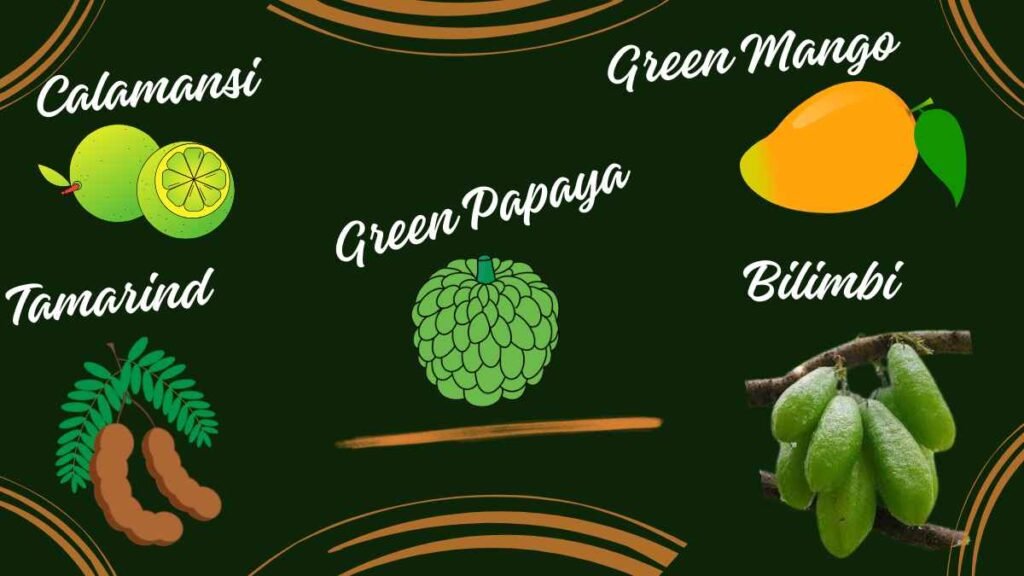How to make Sinigang Soup: Ingredient & Serving Style
Sinigang soup that rules the hearts of Filipinos. This delicious soup starts with simmering pork, shrimp, or beef in water with aromatic vegetables like onions and tomatoes. The main ingredient is the souring agent, traditionally tamarind. Once the meat is tender, add leafy greens such as spinach or water spinach, and season with fish sauce for depth. Serve hot with steamed rice to enjoy every spoonful’s perfect balance of flavors.
Basic Ingredient:
- Meat: Pork (usually belly or ribs), beef (shank or short ribs), or shrimp
- Tamarind: Fresh, paste, or powder (or alternatives like calamansi or green mango)
- Water: For the broth
Vegetables:
- Tomatoes: Fresh, quartered
- Onion: Sliced
- Radish (labanos): Sliced
- Eggplant: Sliced
- Long green beans (sitaw): Cut into pieces
- Water spinach (kangkong): Added at the end of cooking
Seasoning:
- Fish sauce (patis): For umami flavor
- Salt and pepper: To taste
Optional:
- Green chili peppers: For a bit of heat
- Other vegetables: Such as taro or bok choy
Which fruit makes the sinigang soup very sour?

The common fruit that makes sinigang soup very sour is tamarind. It’s commonly used in both fresh and paste forms. Otherwise, alternative fruits also add a tart flavor like calamansi and green mango. Each of these options contributes a distinct tanginess to the dish.
Tamarind
Tamarind is the main ingredient used in sinigang soup. This is one of my favorite ingredients for every dish maker. This pod-like fruit has a tangy, sweet-and-sour flavor that adds depth to the broth. When using fresh tamarind, the pulp is typically extracted by boiling the pods in water. After this straining it to achieve the desired sourness. Tamarind paste is a convenient alternative, offering the same distinct flavor. Its unique tartness balances the savory elements of the meat. Sinigang soup enhances the overall taste.
Calamansi
Calamansi is another popular souring agent used in sinigang. This small citrus fruit, often referred to as Philippine lime, has a vibrant, tart flavor. Calamansi not only contributes acidity but also imparts a fragrant aroma. It is a delightful alternative to tamarind for those who prefer a citrusy twist. It’s commonly found in Filipino households and is used in various dishes. it is making it a versatile staple in the kitchen.
Green Mango
Green mangoes have a firm texture and a sharp, tart taste. When added to sinigang, they impart a unique acidity that pairs well with the savory broth. The fruit can be sliced or cubed and cooked alongside the black paper and salt. Its sourness infuses the soup. Green mango is especially popular in certain regions of the Philippines.
Bilimbi
Bilimbi is not common but equally effective souring in taste. This small, green fruit has a tart flavor that can be quite intense. Bilimbi not only contributes acidity but also adds a uniqueness. that can elevate the complexity of the dish. It’s a great choice for those who explore different souring options in sinigang soup.
Green Papaya
A traditional souring agent, green papaya can also be used in sinigang to add a subtle tartness. especially in some regional variations. This unripe version of papaya has a mild flavor and firm texture. which helps absorb the soup’s savory broth. When cooked, green papaya can release a hint of natural acidity. Additionally, it adds nutritional value and a unique texture to the dish.
Why Sinigang Soup is the most delicious soup in the world?
Sinigang soup is often hailed as one of the most delicious soups in the world for several reasons:
Complex Flavor Profile
Sinigang is renowned for its balance of flavors sour, and slightly sweet. The use of tamarind or other souring agents. which creates a bright acidity that cuts through the richness of the meat. While the addition of vegetables enhances the overall taste.
Comfort Food
For Filipinos, sinigang soup is a comfort food that is the reason for family gatherings. Its warming qualities make it a go-to dish, especially on rainy days.
Versatility
This soup is not made from only one meat but also different varieties of meat. It is customized with different vegetables, allowing for endless variations. This adaptability makes it appealing to a wide range of palates.
Fresh Ingredients
The combination of seasonal vegetables and herbs adds freshness. Fresh fish enhances the overall experience.
Cultural Significance
Sinigang is in Filipino culture and tradition. People here use this dish a lot for get-togethers. It is served during special occasions and family meals. that’s why it is a symbol of togetherness and shared experiences.
These factors, combined with its unique taste and heartwarming nature.
Is sinigang the national dish of the Philippines?
This dish has not been officially announced but it is the glory of hearts. It’s celebrated as a quintessential Filipino comfort food, widely loved across the country. The dish represents Filipino culinary traditions, showcasing the use of local ingredients. Balance of flavors that reflect the country’s diverse culture.
Other dishes, like adobo, are also contenders for the title of national dish. It highlights the rich and varied nature of Filipino cuisine. Its unique sour flavor and adaptability. It holds a special place in the hearts of many Filipinos.
What else should be served with sinigang soup to make it delicious?
For preparing meals sinigang soup is truly delicious. You can serve it with a variety of complementary dishes and sides. Here are some great options:
Steamed Rice
Plain steamed white rice is a classic pairing. It helps to balance the soup’s sourness and soak up the flavorful broth.
Grilled or Fried Fish
Serving grilled or fried fish, like bangus (milkfish) or tilapia, adds a crispy texture.
Fried Tofu or Tempeh
For a vegetarian option, fried tofu or tempeh can provide a hearty addition.
Eggplant or Bitter Melon Salad
A side salad made with grilled eggplant or bitter melon. It is dressed lightly with vinegar or soy sauce can offer a refreshing contrast.
Pancit (Noodle Dishes)
If this noodle dish is served with this soup, it makes your soup more effective.
Chili Dip or Spicy Sauce
For those who are very fond of spices, serve it with a very smoky heated flavor.
Side Vegetables
If you serve vegetables or sautéed vegetables with the soup, it enhances your soup even more. As bok choy, green beans, or corn.
Pickled Vegetables
Serving pickled vegetables, like atchara (pickled papaya). It can introduce a sweet and tangy element that complements the sour soup. The sinigang flavor creates a more balanced and enjoyable experience.
Conclusion
It is challenging to conclude about this soup but I want to say that it is a very popular and heart-warming dish. In contrast, it is commonly made with various meats. It is also popular as a vegetable soup, allowing for vegetarian variations. Its enduring popularity is that sinigang soup remains a cherished staple in Filipino households.
